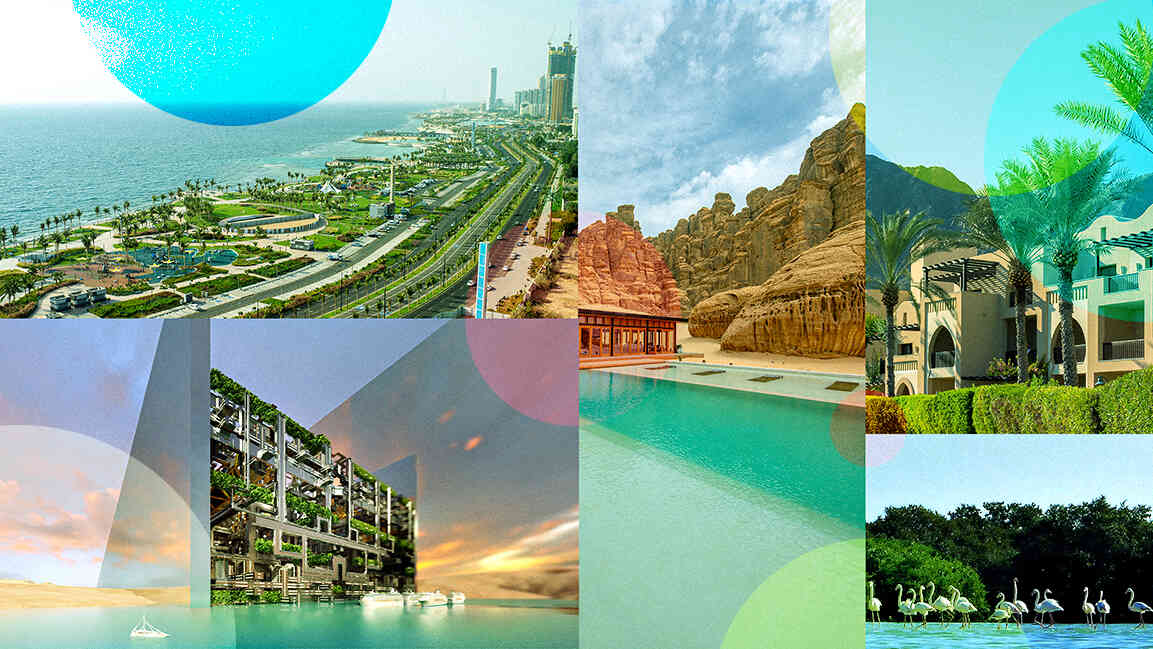- | 8:55 am
Eco-tourism in the desert: Is the Gulf’s sustainable tourism vision achievable?
As Saudi Arabia, the UAE, and Qatar pursue bold tourism ambitions, experts highlight the need for transparency, accountability, and region-specific standards to overcome geographical and environmental constraints.

Over the years, Gulf countries have undergone a massive transformation, making strategic strides to reposition themselves as global eco-tourism destinations.
Unlike conventional eco-tourism models rooted in lush or temperate geographies, Saudi Arabia, the UAE, and Qatar are pioneering a unique approach, building regenerative tourism experiences within arid and extreme climates, says Abhishek Dadlani, Founder of Lushescapes.
“They are not just adopting sustainability; they are reimagining it in the context of desert ecosystems.”
DIFFERENT PATHS, ONE SHARED DESERT
While the Gulf countries share one desert, they pursue very different strategies, notes Dr. Soud Al Thani, Director of Climate Change and Carbon Management at Earthna Center for a Sustainable Future (Qatar Foundation).
“Saudi Arabia is going big and bold, turning vast, untouched coastlines into high-tech, green tourism hubs,” he says, highlighting mega-projects like the Red Sea developments.
Meanwhile, the UAE is integrating sustainability into an already thriving tourism sector. “You can find green building standards in Dubai’s hotels and conservation-driven resorts like those in Abu Dhabi,” Dr. Al Thani adds.
In contrast, Qatar is adopting a boutique, research-driven approach. “We focus on niche projects — preserving mangroves, building eco-friendly cultural sites, and leveraging our academic community to guide these efforts,” he says.
GAP BETWEEN VISION AND REALITY
Despite ambitious visions, the realities are more complex, says Maitha Al Matrooshi, Founder of BIRD Collaborative, a UAE startup supported by the Mohammed bin Rashid Innovation Fund.
“The UAE leads in green building and urban planning, yet its tourism remains carbon-intensive and resource-heavy. Saudi Arabia’s mega-projects like NEOM promise regeneration but involve large-scale construction that disrupts ecosystems and local communities. Lastly,
Qatar is shifting toward eco-luxury and heritage tourism, but its sustainability claims, especially around the World Cup, have been widely challenged.”
She adds that a common challenge across the Gulf is balancing bold ambitions with actual systemic change.
HARSH REALITIES
Admittedly, the harsh desert environment only complicates sustainability efforts. “The desert is a difficult environment for anyone trying to build something green,” says Dr. Al Thani. “Water is scarce, temperatures are extreme, and every little oasis of life is precious. You need to rethink everything, from energy for cooling to water for guests and materials that don’t bake in the sun.”
Waste management challenges, long-haul travel carbon footprints, and a shortage of local green building expertise all add to the complexity. “Efforts must navigate cultural and social dynamics to engage local communities meaningfully,” Al Matrooshi says.
According to Dr. Al Thani, strong policy frameworks and a shift in mindset are critical. “Policy must incentivize using less and recycling more, and developers must commit to sustainable practices from the start.”
Education is equally important. “Everyone — from architects to tourists — must understand why, for example, a native drought-tolerant plant is used instead of a thirsty lawn. The desert doesn’t give many chances for redoes, so our margin for error is almost zero.”
Despite these challenges, experts agree that there is substantial progress in the region. Dr. Al Thani highlights examples of real-world progress in Qatar, from solar panels powering desert camps to Bedouin-style resorts recycling greywater.“There’s substance behind the slogans,” he says, adding that ambitious branding forces them to deliver.
Initiatives within the UAE include investments in sustainable aviation fuel, carbon offset programs, and shifts toward solar-powered resorts. Promoting longer stays, electric transport, and consumer education through carbon labeling are key strategies, Al Matrooshi says.
In Saudi Arabia, the AlUla project is a thoughtful model that deeply integrates preservation, cultural heritage, and sustainability. The emphasis on minimal environmental disruption and celebration of local Bedouin culture are promising signs.
CONTRIBUTION TO SUSTAINABLE DEVELOPMENT
These efforts are also necessary for the Gulf countries if they align closely with modern travelers’ expectations. “Today’s high-net-worth and emerging conscious travelers are seeking meaning beyond luxury — they want to support destinations that are actively part of the solution,” says Dadlani.
Andrew Baturin, CMO of Tumodo, notes that these flagship initiatives in Saudi Arabia, the UAE, and Qatar also play a crucial role in repositioning the region’s image, particularly in the business travel sector. “For companies focused on reducing their carbon footprints, the Gulf’s shift towards sustainable tourism aligns perfectly with broader sustainability strategies,” says Baturin, sharing how they help companies track carbon emissions, automate green travel policies, and provide real-time emissions insights.
Eco-tourism is also becoming a powerful tool for local economic development. “Based on our interactions with eco-resorts, the real strength lies in engaging local communities,” says Al Matrooshi. Training and employing locals as guides, hosts, and artisans helps keep profits within the region while preserving cultural traditions through experiences such as camel treks, falconry, and desert festivals.
PUBLIC AWARENESS AND PARTNERSHIPS MATTER
However, experts note that addressing the gap between ambition and implementation requires more than investment—it demands societal engagement. “Public awareness might seem overused, but it’s essential to build buy-in beyond decision-makers,” says Dr. Al Thani. “If locals and visitors aren’t aware of why a site is special or fragile, how can we expect them to protect it?”
Cross-pollination between research and development leads to innovations like desert-adapted cooling systems and community-driven tourism programs. “In short, awareness builds a culture of sustainability, and partnerships create the tools to achieve it. Together, they are the heroes behind sustainable tourism.”
MOVING BEYOND GREENWASHING
From developers to operators, stakeholders must embed ESG frameworks throughout planning, execution, and reporting. Daldani says. He warns that foundational systems like supply chains, renewable energy, and waste management are still developing, and bridging these gaps will require long-term education and enforcement.
Dr. Al Thani also underscores the need for clear regional metrics: “We must measure what we treasure. Water usage, recycling rates, and biodiversity indexes should be prioritized alongside carbon footprint measurements.”
He also proposes a Gulf-specific sustainability scorecard: “Why not require every eco-tourism project to publish an annual ‘green audit’? It would hold everyone accountable and force innovation beyond cosmetic changes.”
Underpinning this is the need for greater accountability to ensure long-term success: “Everyone involved must be held to real standards,” says Al Matrooshi. “Trusted certifications, regular audits, and transparent reporting are essential. At the end of the day, so much can be done in eco-tourism. It might take time, but if done properly, the Gulf could become one of the world’s true leaders in sustainable desert tourism.”






































